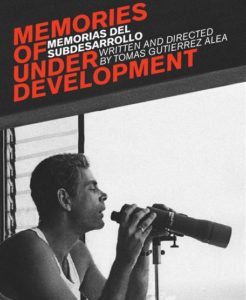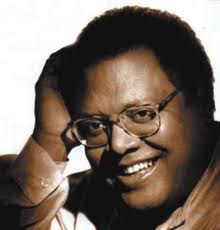In the first days of 1959 the new government created a cinematographic department within the Culture division of the Rebel Army (Dirección de Cultura del Ejército Rebelde), which sponsored the production of documentaries such as “Esta Tierra Nuestra” by Tomás Gutiérrez Alea, and “La Vivienda” by Julio García Espinosa. This was the direct ancestor of what would eventually become the ICAIC (Instituto Cubano del Arte y la Industria Cinematográficos), which was founded in March (1960) as a result of the first culture law of the revolutionary government. Film, according to this law, is “the most powerful and provocative form of artistic expression, and the most direct and widespread vehicle for education and bringing ideas to the public.” From its foundation up until 1980, Alfredo Guevara was head of the ICAIC. Under his direction, the organization was pivotal in the development of Cuban cinema which came to be identified with anti-imperialism and revolution.
The first ten years of the institution were called by critics, the Golden Age (Década de Oro) of Cuban cinema, most of all because of the making of Lucía (1969) by Humberto Solás and Memorias del subdesarrollo (1968) by Tomás Gutiérrez Alea. These two directors are often regarded as the best film directors to have come out of Cuba. Memorias del subdesarrollo was selected among the best 100 films of all times by the International Federation of Film-Clubs. One of the most prolific and strong branches of the Cuban cinema in the last 40 years has been documentaries and short-films. The documentary Now (1965) by Santiago Álvarez is often considered the first video clip in history.[citation needed] It combines a song with an uninterrupted sequence of images depicting racial discrimination in the U.S..
Animation has also been a major highlight in the last decades. In 1974 Juan Padrón gave birth to Elpidio Valdés, a character that represents a mambí fighter, struggling for Cuban independence against the Spanish occupation in the 19th century. It is very popular among Cuban children. Another great success of Cuban animation was the full-length film Vampiros en La Habana (1983), also by Juan Padrón.
Essential in the history of Cuban cinema is the Noticiero ICAIC Latinoamericano (Latin-American ICAIC News) whose first director was Alfredo Guevara. Years later it was directed by Santiago Álvarez and the Mexican Rodolfo Espino, the most successful documentary maker in the island. In 1979 the ICAIC played a key role in the creation of the Festival Internacional del Nuevo Cine Latinoamericano (International Festival of New Latin American Cinema) allowing Latin American films a more international audience. The festival is one of the most important of its type in Latin America and has been held in Havana every year since 1979. There is also an international cinema university, the Escuela Internacional de Cine, Televisión y Video de San Antonio de los Baños (International School of Cinema, Television and Video of San Antonio de los Baños) located in San Antonio de los Baños near Havana, on land donated by the Cuban government and supported by the Fundación del Nuevo Cine Latinoamericano, Gabriel García Márquez and the Father of the New Latin American Cinema, Fernando Birri. Hundreds of young students from all over Latin America have studied direction, script, photography and edition.
The contribution of the ICAIC, which was rapidly positioned as the head of a process aiming for legitimate artistic values and expression of nationality, is not limited only to the support in producing and promoting a movement that spanned fiction, documentary and animation, but also allowed for the exhibition and spread of popular knowledge of the best of cinema from all over the world. It also created the film archives of the Cinemateca de Cuba, and took part in initiatives such as Cinemóviles, which made cinema available on the most intricate sites of the national geography.
The institution also helped developing the Cuban poster, as a mean of promoting films. It gave birth between 1969 and 1977, to the Grupo de Experimentación Sonora, which influenced Cuban music to a great extent, serving as a starting point for the movement of the Nueva Trova. Figures like Silvio Rodríguez, Pablo Milanés and Leo Brouwer were prominent through all this process.
In 1980, Alfredo Guevara was ousted from his position as head of the ICAIC, which he had held since its formation, over controversies about the film Celia. The film, directed by Humberto Solás, was based on the 19th century Cuban novel, Cecilia Valdés. It was the most ambitious Cuban film to date and somewhat monopolized the funds available to filmmakers during its production. This, coupled with the fact that many other directors and the general public did not agree with Solás’ interpretation of the film, led to the removal of Alfredo Guevara from his position.
Having won a great deal of autonomy from the central government in the 1970s, the ICAIC, under the new leadership of Julio García Espinosa, was allowed to make many films dealing with sociopolitical issues. Espinosa was able to increase the recognition of Cuban film and especially of the International Festival of New Latin American Cinema by obtaining greater funds from the government and also inviting big names such as Francis Ford Coppola, Sidney Pollack, Robert De Niro, and Jack Lemmon to the island. Despite his successes, Espinosa faced a large problem in 1991, again due to a controversial film. This film, entitled Alicia en el pueblo de Maravillas, was very critical of the bureaucracy of the government. This, combined with the simultaneous collapse of the Soviet Union, led to Espinosa’s retirement.
During this time, Alfredo Guevara returned to the scene of the ICAIC in order to help it maintain its autonomy from the central government. Many of the party faithful were calling for the organization to merge with the Cuban Radio and Television Institute. Due to the loss of Cuba’s largest trading partner, the Soviet Union, the future of the island country became uncertain, and criticism of the government, which the ICAIC was known for, became unpopular. Guevara managed to get the film released and allow the ICAIC to keep its independent status. He then remained president of the organization throughout the Special Period until his retirement in 2000.
One of the most notable Cuban films in the recent years was ‘Fresa y Chocolate’ (1993) by Tomás Gutiérrez Alea and Juan Carlos Tabío. It is about intolerance, and portrays the friendship between a homosexual and a young member of the Unión de Jóvenes Comunistas (a Communist Youth Organization). It was also the first Cuban production to ever be nominated for the Oscars.
Omar González succeeded Alfredo Guevara as the head of the ICAIC and remains in that position today. It continues to directly aid in the production and distribution of films and has production offices, issues film permits, rents studios and equipment to filmmakers, and is closely involved in each stage of the film, from its inception and production, to its distribution and release.
Many films has produced the ICAIC from 1959-2016. Many of them has been filmed together with the cooperation of other countries and foreign industries.
Agencies/Wiki/InternetPhotos/youtube/Arnoldo Varona/thecubanhistory.com
THE CUBAN HISTORY, HOLLYWOOD.
LA INDUSTRIA CINEMATOGRÁFICA CUBANA (1959-2016).
En los primeros días de 1959 el nuevo gobierno creó un departamento cinematográfico dentro de la división de la Cultura del ejército Rebelde (Dirección de Cultura del Ejército Rebelde), que patrocinó la producción de documentales como “Esta Tierra Nuestra” por Tomás Gutiérrez Alea y “La Vivienda” por Julio García Espinosa. Esto era el antepasado directo de lo que se haría finalmente el ICAIC (Instituto Cubano del Arte y la Industria Cinematográficos), que se fundó en marzo (1960) a consecuencia de la primera ley de la cultura del gobierno revolucionario. La película, según esta ley, es “la forma más potente y provocativa de la expresión artística y el vehículo más directo y extendido para la educación y trayendo ideas del público”. De su fundación hasta 1980, Alfredo Guevara era el jefe del ICAIC. Bajo su dirección, la organización era fundamental en el desarrollo del cine cubano que vino para identificarse con anti-imperialismo y revolución.
Los diez primeros años de la institución fueron llamados por críticos, la Edad de oro (Década de Oro) del cine cubano, sobre todo debido a la fabricación de Lucía (1969) por Humberto Solás y Memorias del subdesarrollo (1968) por Tomás Gutiérrez Alea. Estos dos directores a menudo se consideran como los mejores directores de cine para haber salido de Cuba. Memorias del subdesarrollo fue seleccionado entre las 100 mejores películas de todos los tiempos por la Federación internacional de clubes de la Película. Una de las ramas más prolíficas y fuertes del cine cubano en los 40 años pasados ha sido documentales y películas cortas. El documental Ahora (1965) por Santiago Álvarez a menudo se considera el primer clip de vídeo en la historia. [la cita necesitó] combina una canción con una secuencia ininterrumpida de imágenes que representan la discriminación racial en los Estados Unidos.
La animación también ha sido un toque de luz principal en las décadas pasadas. En 1974 Juan Padrón dio a luz a Elpidio Valdés, un carácter que representa a un luchador mambí, que lucha por la independencia cubana contra la ocupación española en el 19no siglo. Es muy popular entre niños cubanos. Otro gran éxito de la animación cubana era la película de largo metraje Vampiros en La Habana (1983), también por Juan Padrón.
Esencial en la historia del cine cubano es el Noticiero ICAIC Latinoamericano (Noticias ICAIC latinoamericanas) cuyo primer director era Alfredo Guevara. Unos años más tarde fue dirigido por Santiago Álvarez y el mexicano Rodolfo Espino, el fabricante documental más afortunado en la isla. En 1979 el ICAIC desempeñó un papel fundamental en la creación del Festival Internacional del Nuevo Cine Latinoamericano (El Festival internacional del Nuevo Cine latinoamericano) permiso de películas latinoamericanas un auditorio más internacional. El festival es uno de los más importantes de su tipo en América Latina y se ha sostenido en La Habana cada año desde 1979. También hay una universidad del cine internacional, Escuela Internacional de Cine, Televisión y Video de San Antonio de los Baños localizado cerca de La Habana, en tierra donada por el gobierno cubano y apoyada por Fundación del Nuevo Cine Latinoamericano, Gabriel García Márquez y el Padre del Nuevo Cine latinoamericano, Fernando Birri. Cientos de estudiantes jóvenes de todas partes de América Latina han estudiado la dirección, la escritura, la fotografía y la edición.
La contribución del ICAIC, que rápidamente se colocó como el jefe de un proceso aspirando valores artísticos legítimos y expresión de la nacionalidad, sólo no se limita con el apoyo en producción y promoción de un movimiento que atravesó la ficción, el documental y la animación, sino también tuvo en cuenta la exposición y la extensión del conocimiento popular del mejor del cine de todo el mundo. También creó los archivos de la película de Cinemateca de Cuba y participó en iniciativas como Cinemóviles, que puso el cine a disposición en la mayor parte de sitios intrincados de la geografía nacional.
La institución también ayudó al desarrollo del cartel cubano, como un medio de promover películas. Dio a luz entre 1969 y 1977, a Grupo de Experimentación Sonora, que influyó en la música cubana en alto grado, sirviendo de un punto de partida para el movimiento de Nueva Trova. Las cifras como Silvio Rodríguez, Pablo Milanés y Leo Brouwer eran prominentes a través de todo este proceso.
En 1980, Alfredo Guevara se expulsó de su posición como la cabeza del ICAIC, que había sostenido desde su formación, sobre controversias sobre la película Celia. La película, dirigida por Humberto Solás, estaba basada en la novela cubana del 19no siglo, Cecilia Valdés. Era la película cubana más ambiciosa hasta ahora y algo monopolizó los fondos disponibles para cineastas durante su producción. Esto, conectado con el hecho que muchos otros directores y el gran público no estuvieron de acuerdo con la interpretación de Solás de la película, llevó al retiro de Alfredo Guevara de su posición.
Habiendo ganado mucha autonomía del gobierno central en los años 1970, el ICAIC, bajo el nuevo mando de Julio García Espinosa, se permitió hacer muchas películas que tratan con cuestiones sociopolíticas. Espinosa era capaz de aumentar el reconocimiento de la película cubana y sobre todo del Festival Internacional del Nuevo Cine latinoamericano obteniendo mayores fondos del gobierno y también invitando a grandes figuras como Francis Ford Coppola, Sidney Pollack, Robert De Niro y Jack Lemmon a la isla. A pesar de sus éxitos, Espinosa afrontó un problema grande en 1991, otra vez debido a una película polémica. Esta película, Alicia en el pueblo de Maravillas titulado, era muy crítica de la burocracia del gobierno. Esto, combinado con el colapso simultáneo de la Unión Soviética, llevó al retiro de Espinosa.
Durante este tiempo, Alfredo Guevara volvió a la escena del ICAIC a fin de ayudarle a mantener su autonomía del gobierno central. Muchos de los fieles del partido pedían que la organización se combinara con la Radio cubana e Instituto de Televisión. Debido a la pérdida del socio comercial más grande de Cuba, la Unión Soviética, el futuro del país insular se hizo incierto, y la crítica del gobierno, por el cual el ICAIC se conocía, se hizo impopular. Guevara logró lanzar la película y permitir que el ICAIC guarde su estado independiente. Entonces permaneció el presidente de la organización a lo largo del Período Especial hasta su retiro en 2000.
Una de las películas cubanas más notables en los años recientes era ‘Fresa y Chocolate’ (1993) por Tomás Gutiérrez Alea y Juan Carlos Tabío. Es sobre la intolerancia y retrata la amistad entre un homosexual y un miembro joven de Unión de Jóvenes Comunistas (una Organización Juvenil comunista). También era la primera producción cubana para alguna vez denominarse por Oscars.
Omar González sucedió a Alfredo Guevara como la cabeza del ICAIC y permanece en esa posición hoy. Sigue ayudando directamente en la producción y la distribución de películas y tiene oficinas de producción, permisos de la película de cuestiones, alquila estudios y equipo a cineastas, y estrechamente se implica en cada etapa de la película, de su inicio y producción, a su distribución y liberación.
Muchas otras películas han producido el ICAIC de 1959-2016. Muchos de ellos se han filmado juntos con la cooperación de otros países e industrias extranjeras.
Agencies/Wiki/InternetPhotos/youtube/Arnoldo Varona/thecubanhistory.com
THE CUBAN HISTORY, HOLLYWOOD.









